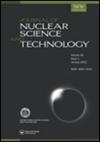AgY对碘的吸附能力及吸附机理研究
IF 1.7
4区 工程技术
Q2 NUCLEAR SCIENCE & TECHNOLOGY
引用次数: 0
摘要
摘要为了系统研究Ag离子交换型NaY分子筛(AgY)对碘化甲酯(CH3I)的吸附性能及吸附机理,选择了不同Ag含量的AgY吸附剂。当渗透CH3I浓度达到1‰和100%时,16.6% AgY可储存150 mg/g和275 mg/g的CH3I。透射电镜和能谱分析结果表明,银的分散性与吸附CH3I的能力密切相关。稳定的AgI络合物的形成使AgY对CH3I的吸附机理合理化。与AgX相比,通过FT-IR、SEM和XRD验证了AgY具有较强的耐酸性能。采用正交试验设计,考察了温度、湿度和气速三个关键参数对CH3I吸附的影响。实验结果表明,AgY在高温、低湿、低流量条件下具有较好的除碘性能。为16.6%AgY在乏燃料后处理装置的进一步工程应用提供了技术参考。本研究得到国家国防科技工业局(ky2007)和国家自然科学基金(U1967215)的支持。披露声明作者未报告潜在的利益冲突。本研究得到国家自然科学基金资助[U1967215];国家国防科技工业局[ky2007]。本文章由计算机程序翻译,如有差异,请以英文原文为准。
Study on iodine adsorption capacity and adsorption mechanism of AgY
ABSTRACTTo systematically study the methyl iodide (CH3I) adsorption performance and adsorption mechanism of Ag ion exchange NaY zeolite (AgY), AgY adsorbents with different Ag content were selected. 16.6% AgY was capable of storing 150 mg/g and 275 mg/g of CH3I when the penetrated CH3I reached 1‰ and 100% inlet concentration. TEM and EDS results presented a high relationship between Ag dispersion and CH3I adsorption capability. The formation of a stable AgI complex rationalized the CH3I adsorption mechanism on AgY. Compared to AgX, AgY was verified to possess a strong acid resistance by FT-IR, SEM and XRD. The effect of three key parameters (temperature, humidity and gas velocity) on CH3I adsorption was carefully investigated by orthogonal experiment design. The experimental results showed that AgY had better iodine removal performance at a high temperature, low humidity, and low flow rate. This work provides technical reference for further engineering applications of 16.6%AgY in spent fuel reprocessing plants.KEYWORDS: Zeolitespent fuelradioactive iodineadsorption AcknowledgementThis research was supported by the State Administration of Science, Technology and Industry for National Defence (KY20007) and the National Natural Science Foundation of China (U1967215).Disclosure statementNo potential conflict of interest was reported by the author(s).Additional informationFundingThis work was supported by the the National Natural Science Foundation of China [U1967215]; the State Administration of Science, Technology and Industry for National Defense [KY20007].
求助全文
通过发布文献求助,成功后即可免费获取论文全文。
去求助
来源期刊

Journal of Nuclear Science and Technology
工程技术-核科学技术
CiteScore
2.40
自引率
16.70%
发文量
116
审稿时长
2.3 months
期刊介绍:
The Journal of Nuclear Science and Technology (JNST) publishes internationally peer-reviewed papers that contribute to the exchange of research, ideas and developments in the field of nuclear science and technology, to contribute peaceful and sustainable development of the World.
JNST ’s broad scope covers a wide range of topics within its subject category, including but are not limited to:
General Issues related to Nuclear Power Utilization: Philosophy and Ethics, Justice and Policy, International Relation, Economical and Sociological Aspects, Environmental Aspects, Education, Documentation and Database, Nuclear Non-Proliferation, Safeguard
Radiation, Accelerator and Beam Technologies: Nuclear Physics, Nuclear Reaction for Engineering, Nuclear Data Measurement and Evaluation, Integral Verification/Validation and Benchmark on Nuclear Data, Radiation Behaviors and Shielding, Radiation Physics, Radiation Detection and Measurement, Accelerator and Beam Technology, Synchrotron Radiation, Medical Reactor and Accelerator, Neutron Source, Neutron Technology
Nuclear Reactor Physics: Reactor Physics Experiments, Reactor Neutronics Design and Evaluation, Reactor Analysis, Neutron Transport Calculation, Reactor Dynamics Experiment, Nuclear Criticality Safety, Fuel Burnup and Nuclear Transmutation,
Reactor Instrumentation and Control, Human-Machine System: Reactor Instrumentation and Control System, Human Factor, Control Room and Operator Interface Design, Remote Control, Robotics, Image Processing
Thermal Hydraulics: Thermal Hydraulic Experiment and Analysis, Thermal Hydraulic Design, Thermal Hydraulics of Single/Two/Multi Phase Flow, Interactive Phenomena with Fluid, Measurement Technology...etc.
 求助内容:
求助内容: 应助结果提醒方式:
应助结果提醒方式:


